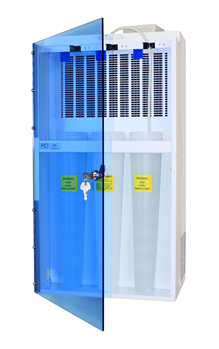How to High-Level Disinfect Ultrasound Transducers, Part II

Before we delve into the high-level disinfection process of ultrasound probes, let's review the highlights that we covered in Part 1:
- Transvaginal, Transrectal, and Transesophageal transducers are semi-critical devices that require high-level disinfection.
- General surface probes should undergo high-level disinfection if a biopsy is performed or when used with high-risk patients.
- Use an FDA-approved high-level disinfectant
- 7 factors to consider when choosing a high-level disinfectant: cycle cost, disinfection time, re-use period, ventilation, contraindications, compatibility, rinse requirements
As stated, high-level disinfection takes place after you have cleaned your probe. Pre-cleaning is a step that is always required, regardless of any disinfection method. As with cleaning, you should wear PPE - a minimum of gloves and goggles is recommended.
Perform an MRC test to test that the high-level disinfectant meets the minimum recommended concentration. Since most high-level disinfectants are reusable for a certain period of time, this step is a critical practice. Follow the disinfectant manufacturer's instructions.
HIGH-LEVEL DISINFECTION:
The most common way to high-level disinfect ultrasound probes is with a GUS Disinfection Soak Station.
 GUS Disinfection Soak Stations:
GUS Disinfection Soak Stations:
- Let you work safely with any high-level disinfectant that has been FDA-approved
- Can disinfect two probes at once
- Protect staff from toxic vapors and fumes with proprietary organic filters that are impregnated with carbon
- Lower operating costs - typically pennies per reprocessing cycle
- Protect ultrasound probes by suspending them with a grip clip
- Provide flexibility - the safety door allows you to use them in a patient area. Counter-top or wall-mounted models.
- Use 75% less disinfectant than open-soak containers or jars
- Meet OSHA and Joint Commission Standards
With over 18,000 GUS systems installed in over 6,000 facilities, GUS Disinfection Soak Stations have been proven effective in protecting staff from toxic vapors and preventing damage to ultrasound probes. GUS stations are reasonably priced (starting at $789) and very inexpensive to operate (pennies per reprocessing cycle).
If you are considering other disinfection methods, make sure that they meet FDA standards. At the recent SDMS conference, we were surprised to meet a few attendees who did the following:
- Used wipes and spray for high-level disinfection. Wipes and sprays are used for low or mid-level disinfection. They do not meet the FDA standards for high-level disinfection!
- Some per diem techs explained that they were limited to their visiting facility's resources. The bottom line is that the owner of the ultrasound system owns the responsibility for disinfecting the probe and protecting staff and patients. The Joint Commission and CMS surveyors will assess the facility to see that it provides the right resources for high-level disinfection and that high-level disinfection takes place.
- Others shared that they used high-level disinfectants, but didn't have proper ventilation. They simply used a jar with a lid and hoped that they were not at risk to exposure because they rarely entered the room or opened the container. These jars use three times as much disinfectant, but more importantly, they do not meet ANSI/AMMI requirements for proper ventilation. Stay tuned for our upcoming blog on ventilation.
Important to note when disinfecting:
- Adhere to the soak time recommended by the disinfectant manufacturer
- Never rinse or submerge the electrical connector
- Always protect the distal tip of the transducer
In addition to ensuring that proper high-level disinfection is practiced, CMS surveyors look to see that instruments are:
-
Disinfected for the appropriate length of time as specified by manufacturer's instructions or evidence-based guidelines
-
Disinfected at the appropriate temperature as specified by manufacturer's instructions or evidence-based guidelines
RINSING:
After the high-level disinfection, follow your Infection Control policies for rinsing. Some disinfectant manufacturers require a single rinse, whereas others recommend 3 separate rinses. All of the GUS Disinfection Soak Stations have an initial rinse container to prevent dripping and off-gassing when you walk to the sink for the final rinse. Many of our customers do a final rinse for 60 seconds with running cold water. If you're using a hydrogen peroxide disinfectant like RESERT XL HLD, you only need to do a single rinse which you can do with the GUS rinse container.
STORAGE, SPILL KITS & NEUTRALIZATION:
CMS and Joint Commission will look to see that you store your probe in a designated area to prevent contamination. OSHA will look to see that you have a spill kit nearby. Some states and municipalities require that you neutralize the high-level disinfectant before you dispose of it. You can read more about spill kits and neutralization in these previous blogs:






